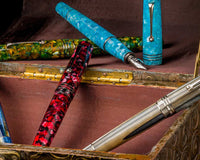To my one-time partner in poetic truancy,
It’s been almost half a lifetime since we’ve spoken, hasn’t it? I saw one of your posts on social media a while back, and it got me reminiscing about that one year we became classmates. I realized that within my mixed bag of memories from that time, our little moments were considerably some of my happiest. The poetry you’d shared with me during our sleep-inducing classes still makes me smile. Do you remember that time when we were almost caught? We were so young back then, our hearts braver and less distilled. Since then, I’ve always believed you’d become a writer one day.
And now, my prediction has become reality. I admire your courage — for going to places far too dangerous for my own comfort in the name of truth. I’m also glad to discover that your quietly passionate heart has made a home with your family. May you all continue to be safe and happy.
As for me, writing poetry still continues to bring me joy. I’ve found it quite freeing when making sense of my inner world. I also have a family now, and my son has shown a penchant for writing as well. However, he shines more through his essays for school.
Enclosed is a fountain pen, ink, and some paper — in honor of the friendship that began through our shared interest. On the off chance that you haven’t any of these yet, I’d like to introduce you to these wonderful tools of creation. I hope you’ll find writing with them as pleasurable as it is for me. And perhaps, send me a letter in reply?
Your long-lost comrade-in-words,
Alex
A Peek Into History
Letters were born from our natural desire to communicate with each other. Since the invention of symbols for language, the letter has evolved along with writing implements, literacy, and means of transportation. The first recorded handwritten letter is said to be from Queen Atossa of Persia in 500 BC according to the ancient historian Hellanicus. Across different cultures through time, letters have been sent to provide information, disseminate opinions, and foster social relations.

During the Byzantine era, letter writing was considered to be an art form or genre of literature known as epistolography. It was connected to the art of rhetoric and favored by the intellectual elite. In the 17th-18th century, the epistolary novel gained recognition in literature, wherein personal letters illustrated the story of people’s lives and their society. One prime example of publishing such “private” correspondence is Love-letters Between a Nobleman and His Sister by Aphra Behn.
Since the advent of telegraphy, telephony, and the internet, handwritten letters have lost their predominant position in business and personal communication. However, their permanence and ubiquitousness has continued to provide historians with a wealth of source material for study. In this sense, letters have become artifacts, providing a window for understanding a person’s social environment during that time.
A Case For Handwritten Letters
In spite of the relative ease that technology places at our fingertips, why do we continue to write letters? And why does receiving one have such significance?
For both sender and recipient, it is that personal touch. The sender takes their time, carving out space in their life, and choosing their words to create a letter. It speaks of attention and consideration that is concrete enough to be touched, perhaps significant enough to be treasured. Traveling through space and time, a letter arrives bearing the unique voice of the sender, echoing in their tone of writing and choice of words. Their personality or state of mind can be felt through their penmanship and the little aesthetic details that comprise the letter itself. This is the reason why personal letters from historical figures lend more depth to the individuals themselves and a more nuanced perspective when included in their biographies. For both parties, there is an emotional aspect made keener by the waiting time from the letter being sent, received, and replied to.

On a more physiological note, writing letters by hand benefits our well-being. It engages our visual and tactile senses, and fires up those neural pathways responsible for cognition, memory, and spatial recognition. Letter writing is still one of the learning exercises included when teaching penmanship to school-age children. A handwritten letter can likewise serve as a medium for self-expression and creativity — allowing you to share your emotions and insights with another in your own way. The focused awareness enabled during the act of expressive writing is therapeutic in itself.
The Quintessential Partners
Hand. Written. Letters. Fountain pen. Ink. Paper. (I feel like I’m preaching to the choir, haha.)
Since April is National Card and Letter Writing Month, let us uncap our favored fountain pens and let those letters fly! This 30-day holiday was initiated in 2001 by the United States Postal Service to commemorate the efforts made in delivering our mail. Therefore, let us celebrate by putting our pens, inks, and paper through their paces to revitalize the art of letter writing. You can also stretch those creative muscles by crafting your own card embellished with calligraphy or drawings. Reach out through a letter to old friends and family, or surprise a loved one with a gift and a handmade card. Given how pleasurable it is to use fountain pens and how versatile inks can behave, this is a wonderful opportunity to explore their capabilities, express yourself, and connect.

This April, let’s make “You’ve got mail.” more analog!
A letter always seemed to me like immortality because it is the mind alone without corporeal friend.
― Emily Dickinson

Use the code LEKZ10 to get a 10% discount!
* Not applicable for HopDrop, Clearance, On Sale items, and select brands.
Written by @lekzumali
Check out her musings on Instagram!







